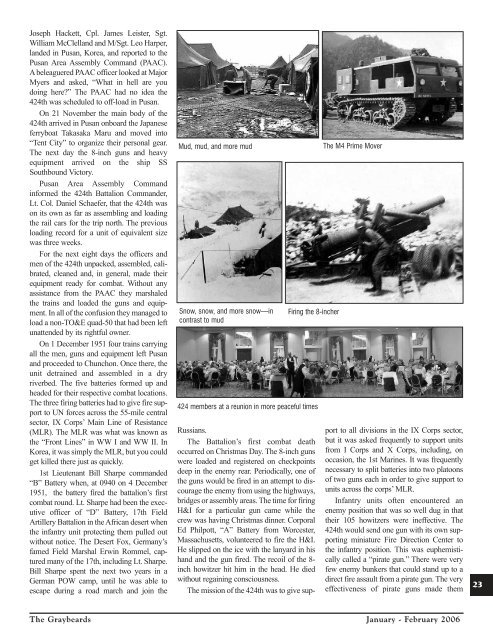Jan/Feb 2006 - Korean War Veterans Association
Jan/Feb 2006 - Korean War Veterans Association
Jan/Feb 2006 - Korean War Veterans Association
You also want an ePaper? Increase the reach of your titles
YUMPU automatically turns print PDFs into web optimized ePapers that Google loves.
Joseph Hackett, Cpl. James Leister, Sgt.<br />
William McClelland and M/Sgt. Leo Harper,<br />
landed in Pusan, Korea, and reported to the<br />
Pusan Area Assembly Command (PAAC).<br />
Abeleaguered PAAC officer looked at Major<br />
Myers and asked, “What in hell are you<br />
doing here?” The PAAC had no idea the<br />
424th was scheduled to off-load in Pusan.<br />
On 21 November the main body of the<br />
424th arrived in Pusan onboard the Japanese<br />
ferryboat Takasaka Maru and moved into<br />
“Tent City” to organize their personal gear.<br />
The next day the 8-inch guns and heavy<br />
equipment arrived on the ship SS<br />
Southbound Victory.<br />
Pusan Area Assembly Command<br />
informed the 424th Battalion Commander,<br />
Lt. Col. Daniel Schaefer, that the 424th was<br />
on its own as far as assembling and loading<br />
the rail cars for the trip north. The previous<br />
loading record for a unit of equivalent size<br />
was three weeks.<br />
For the next eight days the officers and<br />
men of the 424th unpacked, assembled, calibrated,<br />
cleaned and, in general, made their<br />
equipment ready for combat. Without any<br />
assistance from the PAAC they marshaled<br />
the trains and loaded the guns and equipment.<br />
In all of the confusion they managed to<br />
load a non-TO&E quad-50 that had been left<br />
unattended by its rightful owner.<br />
On 1 December 1951 four trains carrying<br />
all the men, guns and equipment left Pusan<br />
and proceeded to Chunchon. Once there, the<br />
unit detrained and assembled in a dry<br />
riverbed. The five batteries formed up and<br />
headed for their respective combat locations.<br />
The three firing batteries had to give fire support<br />
to UN forces across the 55-mile central<br />
sector, IX Corps’ Main Line of Resistance<br />
(MLR). The MLR was what was known as<br />
the “Front Lines” in WW I and WW II. In<br />
Korea, it was simply the MLR, but you could<br />
get killed there just as quickly.<br />
1st Lieutenant Bill Sharpe commanded<br />
“B” Battery when, at 0940 on 4 December<br />
1951, the battery fired the battalion’s first<br />
combat round. Lt. Sharpe had been the executive<br />
officer of “D” Battery, 17th Field<br />
Artillery Battalion in the African desert when<br />
the infantry unit protecting them pulled out<br />
without notice. The Desert Fox, Germany’s<br />
famed Field Marshal Erwin Rommel, captured<br />
many of the 17th, including Lt. Sharpe.<br />
Bill Sharpe spent the next two years in a<br />
German POW camp, until he was able to<br />
escape during a road march and join the<br />
Mud, mud, and more mud<br />
Snow, snow, and more snow—in<br />
contrast to mud<br />
Firing the 8-incher<br />
424 members at a reunion in more peaceful times<br />
The M4 Prime Mover<br />
Russians.<br />
The Battalion’s first combat death<br />
occurred on Christmas Day. The 8-inch guns<br />
were loaded and registered on checkpoints<br />
deep in the enemy rear. Periodically, one of<br />
the guns would be fired in an attempt to discourage<br />
the enemy from using the highways,<br />
bridges or assembly areas. The time for firing<br />
H&I for a particular gun came while the<br />
crew was having Christmas dinner. Corporal<br />
Ed Philpott, “A” Battery from Worcester,<br />
Massachusetts, volunteered to fire the H&I.<br />
He slipped on the ice with the lanyard in his<br />
hand and the gun fired. The recoil of the 8-<br />
inch howitzer hit him in the head. He died<br />
without regaining consciousness.<br />
The mission of the 424th was to give support<br />
to all divisions in the IX Corps sector,<br />
but it was asked frequently to support units<br />
from I Corps and X Corps, including, on<br />
occasion, the 1st Marines. It was frequently<br />
necessary to split batteries into two platoons<br />
of two guns each in order to give support to<br />
units across the corps’ MLR.<br />
Infantry units often encountered an<br />
enemy position that was so well dug in that<br />
their 105 howitzers were ineffective. The<br />
424th would send one gun with its own supporting<br />
miniature Fire Direction Center to<br />
the infantry position. This was euphemistically<br />
called a “pirate gun.” There were very<br />
few enemy bunkers that could stand up to a<br />
direct fire assault from a pirate gun. The very<br />
effectiveness of pirate guns made them<br />
23<br />
The Graybeards<br />
<strong>Jan</strong>uary - <strong>Feb</strong>ruary F<br />
<strong>2006</strong>

















